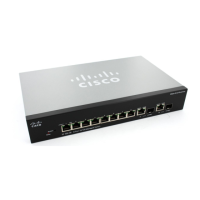Configuring IP Information
Management and IP Interfaces
Cisco Small Business 300 Series Managed Switch Administration Guide 169
15
The following sections describe the differences between IP addressing when the
switch is in Layer 2 or Layer 3 mode.
Layer 2 IP Addressing
In Layer 2 mode, the switch has a single IP address in the management VLAN. This
IP address and the default gateway can be configured with a static IP address, or
by DHCP. The static IP address and default gateway for Layer 2 mode are
configured on the IPv4 Interface Page. In Layer 2 mode, the switch uses the
default gateway, if configured, to communicate with devices that are not in the
same IP subnet with the switch. By default, VLAN 1 is the management VLAN, but
this can be modified. Operating in Layer 2 mode, the switch can only be reached
at the configured IP address through its management VLAN.
Layer 3 IP Addressing
In Layer 3 mode, the switch can have multiple IP addresses. Each IP address can
be assigned to specified ports, LAGs, or VLANs. These IP addresses are
configured in the IPv4 Interface Page in Layer 3 mode. This provides more
network flexibility versus the Layer 2 mode, in which only a single IP address can
be configured. Operating in Layer 3 mode, the switch can be reached at all its IP
addresses from the corresponding interfaces.
A predefined, default route is not provided in Layer 3 mode. To remotely manage
the switch, a default route must be defined. Any DHCP-assigned default gateways
are stored as default routes. In addition, you can manually define default routes.
This is defined in the IP Static Routing Page.
NOTE The switch can be switched from Layer 2 mode to Layer 3 mode only by using the
console interface. When this is done, all configuration settings are returned to their
default values. For more information about the console interface, see the Console
Menu Interface chapter in the administration guide.
All the IP addresses configured or assigned to the switch are also referred as
Management IP addresses in this guide.
The following sections include configuration information that is relevant to both
Layer 2 and Layer 3 modes.

